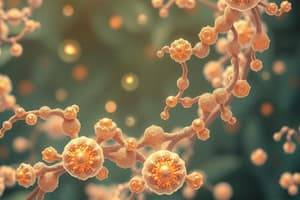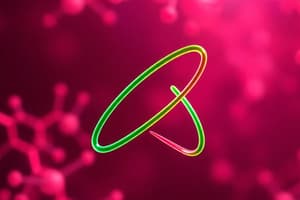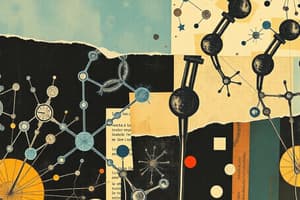Podcast
Questions and Answers
Which statement best describes the role of RNA in gene expression?
Which statement best describes the role of RNA in gene expression?
- RNA functions only during the translation phase.
- RNA serves as a template for transcription and translation processes. (correct)
- RNA is primarily responsible for storing genetic information.
- RNA mediates the conversion of DNA into protein.
What is the main function of hormones in the body?
What is the main function of hormones in the body?
- To directly provide structural support to cellular components.
- To regulate physiological processes and maintain homeostasis. (correct)
- To facilitate the production of energy within mitochondria.
- To store genetic information for immediate use.
Which of the following statements accurately reflects a characteristic of cellular organelles?
Which of the following statements accurately reflects a characteristic of cellular organelles?
- Each organelle has specific functions contributing to overall cellular activity. (correct)
- Mitochondria are solely responsible for gene transcription.
- All organelles have the same function within the cell.
- Organelles operate independently of the cell membrane.
In the context of thermodynamics, which of the following concepts is crucial for understanding biochemical reactions?
In the context of thermodynamics, which of the following concepts is crucial for understanding biochemical reactions?
What primary role does the cell membrane play in cellular function?
What primary role does the cell membrane play in cellular function?
Which of the following correctly describes the role of carbohydrates in living organisms?
Which of the following correctly describes the role of carbohydrates in living organisms?
What is the primary function of lipids within biological systems?
What is the primary function of lipids within biological systems?
Which statement best describes the difference between catabolism and anabolism?
Which statement best describes the difference between catabolism and anabolism?
What role do enzymes play in biochemical reactions?
What role do enzymes play in biochemical reactions?
What is the primary purpose of cellular respiration?
What is the primary purpose of cellular respiration?
In photosynthesis, what is the function of chlorophyll?
In photosynthesis, what is the function of chlorophyll?
Which of the following statements about enzymes is false?
Which of the following statements about enzymes is false?
Which metabolic process requires energy to synthesize complex molecules?
Which metabolic process requires energy to synthesize complex molecules?
Flashcards
What is DNA?
What is DNA?
A type of nucleic acid that stores genetic information and is used as a template for creating RNA.
What is Transcription?
What is Transcription?
The process of converting genetic information from DNA into RNA.
What is RNA?
What is RNA?
A type of nucleic acid that carries genetic information from DNA to ribosomes for protein synthesis.
What is Translation?
What is Translation?
Signup and view all the flashcards
What are hormones?
What are hormones?
Signup and view all the flashcards
What is biochemistry?
What is biochemistry?
Signup and view all the flashcards
What are biomolecules?
What are biomolecules?
Signup and view all the flashcards
Describe carbohydrates.
Describe carbohydrates.
Signup and view all the flashcards
What are lipids?
What are lipids?
Signup and view all the flashcards
What are proteins?
What are proteins?
Signup and view all the flashcards
What are nucleic acids?
What are nucleic acids?
Signup and view all the flashcards
What is metabolism?
What is metabolism?
Signup and view all the flashcards
What are enzymes?
What are enzymes?
Signup and view all the flashcards
Study Notes
Introduction to Biochemistry
- Biochemistry is the study of the chemical processes occurring within and relating to living organisms.
- It encompasses a vast array of topics, including the structure and function of biomolecules, metabolism, and the regulation of biological systems.
- Biochemistry is fundamental to understanding life processes at a molecular level.
Biomolecules
- Biomolecules are the essential organic compounds that make up living organisms.
- The four major classes are: carbohydrates, lipids, proteins, and nucleic acids.
- Carbohydrates: Polyhydroxy aldehydes or ketones. Functions include energy storage (glycogen), structural support (cellulose), and recognition.
- Lipids: Hydrophobic molecules. Diverse functions including energy storage (triglycerides), membrane structure (phospholipids), and hormones (steroids).
- Proteins: Polymers of amino acids. Perform diverse functions like catalysis (enzymes), transport (hemoglobin), structural support (collagen), and movement (actin and myosin).
- Nucleic acids: Polymers of nucleotides. Carry genetic information (DNA and RNA).
Metabolism
- Metabolism refers to the sum of all chemical reactions that occur in an organism.
- It has two major components:
- Catabolism: The breakdown of complex molecules into simpler ones, releasing energy.
- Anabolism: The synthesis of complex molecules from simpler ones, requiring energy.
- Metabolic pathways are interconnected sequences of reactions.
- Enzymes catalyze and regulate these reactions.
Enzymes
- Enzymes are biological catalysts, typically proteins, speeding up metabolic reactions without being consumed.
- They have specific active sites that bind to substrates.
- Enzyme activity is affected by factors like temperature, pH, and substrate concentration.
- Enzyme inhibition, either competitive or noncompetitive, can regulate metabolic pathways.
Cellular Respiration
- A key catabolic pathway.
- Cellular respiration involves the breakdown of glucose to produce ATP, the cell's energy currency.
- The process includes glycolysis, the Krebs cycle, and oxidative phosphorylation.
- Different pathways produce varying amounts of ATP.
Photosynthesis
- A key anabolic pathway.
- Photosynthesis uses light energy to synthesize glucose from carbon dioxide and water.
- Chlorophyll is the primary pigment involved in capturing light energy.
- The process occurs in two stages: light-dependent and light-independent reactions.
Nucleic Acids and Gene Expression
- DNA stores genetic information.
- RNA plays crucial roles in gene expression, including transcription and translation.
- Transcription is the process of converting DNA information into RNA.
- Translation is the process of converting RNA information into protein.
- Gene regulation controls the expression of genes.
Hormonal Regulation
- Hormones are chemical messengers that regulate various physiological processes.
- Hormones can be steroid or peptide hormones.
- They act on target cells to trigger a response.
- Endocrine glands secrete hormones into the bloodstream.
Cellular Structure and Function
- Many biochemical reactions occur within specific cellular compartments, each with unique functionality.
- Organelles like mitochondria are essential for energy production.
- The cell membrane is the boundary controlling the movement of substances in and out of cellular components.
Important Concepts
- Thermodynamics, including the laws of thermodynamics and their application to biochemical processes.
- Free energy, understanding energetic changes involved in biochemical reactions.
- Water, a crucial solvent in biochemical processes, affecting reaction rates and other details.
- Buffer systems regulate pH in biological systems.
Studying That Suits You
Use AI to generate personalized quizzes and flashcards to suit your learning preferences.




